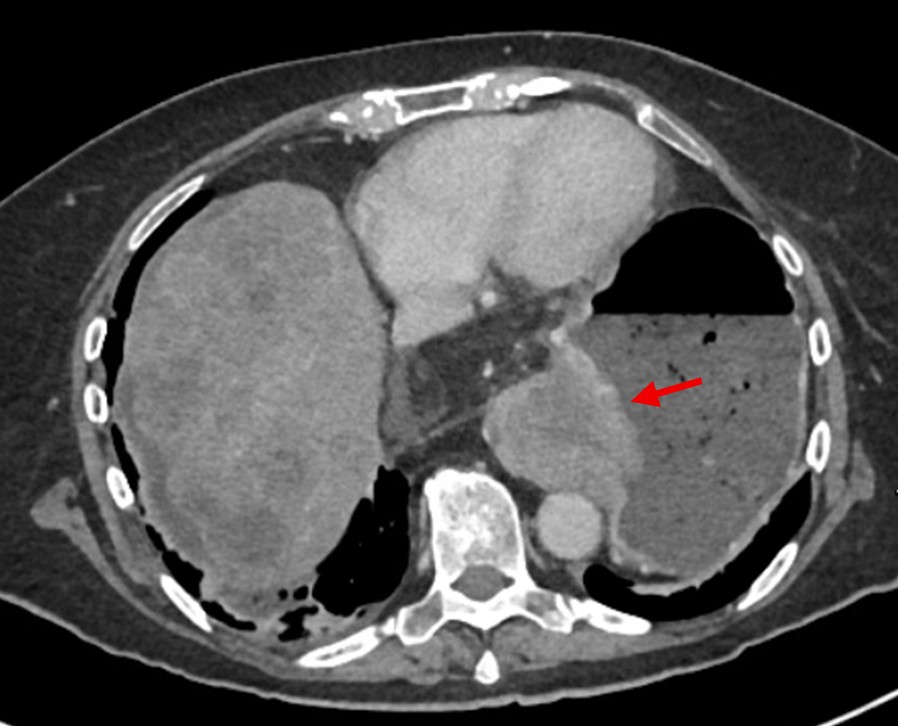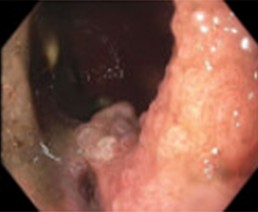Sunday Poster Session
Category: Esophagus
P0703 - Gastroesophageal Junction Neuroendocrine Tumor: A Rare and Challenging Diagnosis
Sunday, October 26, 2025
3:30 PM - 7:00 PM PDT
Location: Exhibit Hall

Rafia Irfan Waheed, MD (she/her/hers)
University of South Dakota Sanford School of Medicine
Sioux Falls, SD
Presenting Author(s)
Rafia Irfan Waheed, MD1, Hareem Tahir, MD1, Kennedy Forest, MD1, Gulzar Ahmed, MBBS2, Nicholas Daane, MD3
1University of South Dakota Sanford School of Medicine, Sioux Falls, SD; 2Dow Medical College, Karachi, Sindh, Pakistan; 3Avera Health, Sioux Falls, SD
Introduction: Neuroendocrine tumors (NETs) are rare malignancies arising from neuroendocrine cells, comprising less than 1% of all gastrointestinal cancers. They often present with vague symptoms, leading to delayed diagnosis. This case is unusual, as NETs rarely occur at the gastroesophageal (GE) junction and are more commonly found in the small intestine, pancreas, and rectum.
Case Description/
Methods: The patient is an 80-year-old female with a past medical history significant for hypothyroidism and type 2 diabetes mellitus. She presented to the Emergency Department with a 6-month history of progressive nausea, vomiting, early satiety, unintentional weight loss, and generalized weakness. She reported being unable to tolerate solid food, managing only minimal oral intake. Initial laboratory investigations were unremarkable. A CT scan of the abdomen and pelvis revealed a mass at the GE junction with evidence of metastases to the liver and lungs, Figure 1.Gastroenterology was consulted, and an esophagogastroduodenoscopy (EGD) was performed. The EGD identified a gastric mass at the GE junction, Figure 2, located 31 cm from the incisors and extending along the posterior wall. Biopsies taken from the mass were non-diagnostic. Given the inconclusive gastric biopsy, a liver biopsy was performed, which revealed a high-grade (Grade 4) neuroendocrine tumor. Oncology was consulted, and treatment options were discussed. Due to the advanced stage and poor prognosis associated with Grade 4 neuroendocrine carcinoma, curative treatment was not feasible. After a detailed discussion of options, the patient and her family elected to pursue a palliative approach focused on comfort measures.
Discussion: This case highlights high-grade neuroendocrine carcinoma (NEC) of the GE junction, a rare and aggressive malignancy often missed on initial biopsy due to its submucosal origin and necrotic or poorly differentiated tissue. Compared to more common esophageal cancers like squamous cell carcinoma and adenocarcinoma, NEC typically presents with vague gastrointestinal symptoms and is often diagnosed at an advanced stage, with early metastasis to organs such as the liver and lungs. Risk factors include smoking, acid reflex and family history, it is important to consider syndromes such as Multiple Endocrine Neoplasia type 1 (MEN1), which, although rare, can be associated with neuroendocrine tumors. Early recognition and a multidisciplinary, patient-centered approach are essential for optimal management.

Figure: Figure 1

Figure: Figure 2
Disclosures:
Rafia Irfan Waheed indicated no relevant financial relationships.
Hareem Tahir indicated no relevant financial relationships.
Kennedy Forest indicated no relevant financial relationships.
Gulzar Ahmed indicated no relevant financial relationships.
Nicholas Daane indicated no relevant financial relationships.
Rafia Irfan Waheed, MD1, Hareem Tahir, MD1, Kennedy Forest, MD1, Gulzar Ahmed, MBBS2, Nicholas Daane, MD3. P0703 - Gastroesophageal Junction Neuroendocrine Tumor: A Rare and Challenging Diagnosis, ACG 2025 Annual Scientific Meeting Abstracts. Phoenix, AZ: American College of Gastroenterology.
1University of South Dakota Sanford School of Medicine, Sioux Falls, SD; 2Dow Medical College, Karachi, Sindh, Pakistan; 3Avera Health, Sioux Falls, SD
Introduction: Neuroendocrine tumors (NETs) are rare malignancies arising from neuroendocrine cells, comprising less than 1% of all gastrointestinal cancers. They often present with vague symptoms, leading to delayed diagnosis. This case is unusual, as NETs rarely occur at the gastroesophageal (GE) junction and are more commonly found in the small intestine, pancreas, and rectum.
Case Description/
Methods: The patient is an 80-year-old female with a past medical history significant for hypothyroidism and type 2 diabetes mellitus. She presented to the Emergency Department with a 6-month history of progressive nausea, vomiting, early satiety, unintentional weight loss, and generalized weakness. She reported being unable to tolerate solid food, managing only minimal oral intake. Initial laboratory investigations were unremarkable. A CT scan of the abdomen and pelvis revealed a mass at the GE junction with evidence of metastases to the liver and lungs, Figure 1.Gastroenterology was consulted, and an esophagogastroduodenoscopy (EGD) was performed. The EGD identified a gastric mass at the GE junction, Figure 2, located 31 cm from the incisors and extending along the posterior wall. Biopsies taken from the mass were non-diagnostic. Given the inconclusive gastric biopsy, a liver biopsy was performed, which revealed a high-grade (Grade 4) neuroendocrine tumor. Oncology was consulted, and treatment options were discussed. Due to the advanced stage and poor prognosis associated with Grade 4 neuroendocrine carcinoma, curative treatment was not feasible. After a detailed discussion of options, the patient and her family elected to pursue a palliative approach focused on comfort measures.
Discussion: This case highlights high-grade neuroendocrine carcinoma (NEC) of the GE junction, a rare and aggressive malignancy often missed on initial biopsy due to its submucosal origin and necrotic or poorly differentiated tissue. Compared to more common esophageal cancers like squamous cell carcinoma and adenocarcinoma, NEC typically presents with vague gastrointestinal symptoms and is often diagnosed at an advanced stage, with early metastasis to organs such as the liver and lungs. Risk factors include smoking, acid reflex and family history, it is important to consider syndromes such as Multiple Endocrine Neoplasia type 1 (MEN1), which, although rare, can be associated with neuroendocrine tumors. Early recognition and a multidisciplinary, patient-centered approach are essential for optimal management.

Figure: Figure 1

Figure: Figure 2
Disclosures:
Rafia Irfan Waheed indicated no relevant financial relationships.
Hareem Tahir indicated no relevant financial relationships.
Kennedy Forest indicated no relevant financial relationships.
Gulzar Ahmed indicated no relevant financial relationships.
Nicholas Daane indicated no relevant financial relationships.
Rafia Irfan Waheed, MD1, Hareem Tahir, MD1, Kennedy Forest, MD1, Gulzar Ahmed, MBBS2, Nicholas Daane, MD3. P0703 - Gastroesophageal Junction Neuroendocrine Tumor: A Rare and Challenging Diagnosis, ACG 2025 Annual Scientific Meeting Abstracts. Phoenix, AZ: American College of Gastroenterology.
